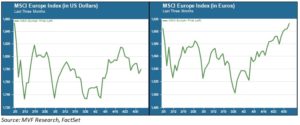
Yes, it’s already May. Three days into the year’s fifth month, we are pleased to say we have not yet had to listen to the first seasonal “sell in May and go away” pronouncement by a stupidly grinning CNBC pundit. It’s coming, though, as surely as May flowers follow April showers. Meanwhile, as equities tread water between the support and resistance levels that were the subject of last week’s commentary, we are giving a second look to one of the key drivers of the default macro narrative: the synchronized global growth theme. In the crosshairs of this analysis is the Eurozone. The Cinderella story of 2017, with a growth trajectory in line with that of the US, seems to be morphing back into one of the dowdy stepsisters.
The Return of La Malaise
We’ve been here of course, before. The economy of the single currency zone experienced an existential crisis in 2011 as Greece’s debt debacle threatened to spread to other troubled “periphery” markets like Italy, Spain and Portugal. Mario Draghi brought it back from a near-coma with his “whatever it takes” avowal in June 2012 and the subsequent introduction of the ECB’s quantitative easing program. But growth languished until a surprising run of data last year. Production output, service sector growth, employment and confidence improved across the region. Inflation, which two years earlier seemed poised to sink into a deflation trap, rebounded and made the ECB’s 2 percent target seem almost reasonable. With Japan also joining in the fun, by the second half of last year the world’s major developed economies seemed almost to be growing in lockstep. “Global synchronized growth” became the go-to shorthand for explaining last year’s good times in risk asset markets.
But real Eurozone GDP growth for the first quarter, released yesterday, came in at 0.4 percent, the lowest quarterly figure in eighteen months. Today, the flash estimate of core inflation (excluding the energy and food & beverage sectors) shows consumer prices growing at just 0.7 percent – not exactly within striking distance of that elusive 2 percent target. As this is the first reading of the data, the jury is still out on what is driving the slowdown (or, for that matter, whether this is just a one-off bump in the road or the onset of something more prolonged).
Euro Up, Euro Down
One possible culprit for the return of stagnation is the currency. In December 2016, at the height of the “Trump trade” follies that took control of investor brains, one euro bought just $1.04. Parity was surely around the corner. Instead, the euro went off on a tear, surging to $1.20 by last fall and then as high as $1.25 earlier this year. The simple rule of thumb is that a strong currency is a drag on an economy’s net exports because it makes those exports less price-competitive on world markets. That drag takes time to show up in actual figures, though, so it is possible that a yearlong appreciation of the euro is finally starting to show up in the GDP data.
If currency is the culprit – and we don’t have enough data yet to arrive at a firm conclusion – then we may get a signal in the not too distant future that the stagnation won’t last for long. The dollar has surged against most major currencies, including the euro, since the middle of April. The euro is back down below the $1.20 threshold. The trend reversal is indicated in fairly striking fashion in the chart below. This shows a side-by-side comparison of the MSCI EU equity index in US dollar (left) and euro (right) terms over the last three months.

The “divergence” trade that many had predicted more than a year ago, with a growing gulf between tighter monetary policy in the US and still-accommodative measures in Europe (and Japan) may be coming into its own. A stronger dollar would be a key presumption of the divergence trade, along with widening spreads between US and Eurozone benchmark yields (the 10-year German Bund yield is around 15 percent off its recent high while the 10-year Treasury is close to its highest levels since 2014).
It is quite possible, of course, that the euro’s trajectory is not the main story when it comes to the question of what may be pushing Europe’s economy out of sync with US growth trends. Not much was ever actually fixed following the 2011-12 crisis – most policy issues and questions about member states’ economic obligations to each other were just kicked down the road to be reckoned with later. The time for reckoning may be at hand. Breaking up the “global synchronized growth” narrative is about the last thing an already jittery market environment needs.